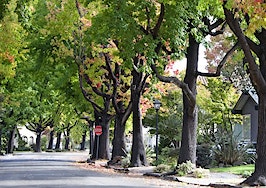At the beginning of each year, many people promise to revamp their health and fitness routine, often starting with a new diet of fresh fruits and veggies. But as Redfin’s latest fresh-food access study reveals, some Americans have to trek a little further to get homegrown food.
Once again, New York City was ranked no. 1 for fresh food access since 75 percent of New Yorkers live no more than five minutes away from a grocery store or year-round farmers market. Philadelphia (64 percent) and Miami (57 percent) rounded out the top three with over half of residents having quick access to fresh produce.
Boston (45 percent to 54 percent), Miami (49 percent to 57 percent) and Baltimore (41 percent to 49 percent) showed the biggest improvements in fresh-food access, with gains of nearly 10 percent since 2014.
-

Source: Redfin
Redfin chief economist Nela Richardson said people often take fresh food access for granted, and don’t understand how it impacts the day-to-day lives of those who live in food deserts — cities where few residents have a grocery store or year-round farmers market within a five-minute walk.
“While visiting my grandfather’s hometown in South Carolina last summer, the only grocery store there had burned down and residents had to travel 20 minutes to the next town to get fresh food,” said Richardson in a statement.
“Many in the community didn’t have transportation or were elderly. Neighbors organized carpools just to make sure people had access to food. This is obviously an extreme example, but it illustrates the importance of this basic amenity that many people take for granted.”
-

Source: Redfin
This year Oklahoma City, Oklahoma and Colorado Springs, Colorado were ranked as the worst food deserts. In each city, only six percent of residents can walk to a grocery store or year-round farmers market within five minutes.
Oklahoma City-based Redfin agent Linda Huynh said the city’s large land size is partially to blame for the low food-access score.
“Oklahoma City has been slower than other cities to adapt to having fresh food, gyms and outdoor activities within walking distance, ” Huynh told Redfin. “But keep in mind, our city is the eighth largest in the U.S. by land, with just 1.5 million residents. Things are really spread out and mostly accessible by car only.”
Although they’re still on the food deserts list, Tucson (10 percent) and Wichita (9 percent) were able to bump up the number of residents with fresh-food access by 4 percentage points.
About the study
To calculate the percentage of city residents with access to healthy food, Redfin used Walk Score data to analyze 48 cities. Walk Score uses population data and city boundaries that come from the U.S. Census, and the list of grocery stores comes from a mix of Google, Localeze and places added via the Walk Score website. Redfin calculated millions of walking routes for this ranking with our Travel Time API to determine how many grocery stores are within a five-minute walk for residents. Redfin’s rankings are proximity based and do not consider the cost of food. Los Angeles and San Francisco were excluded from this report because of unreliable data.





